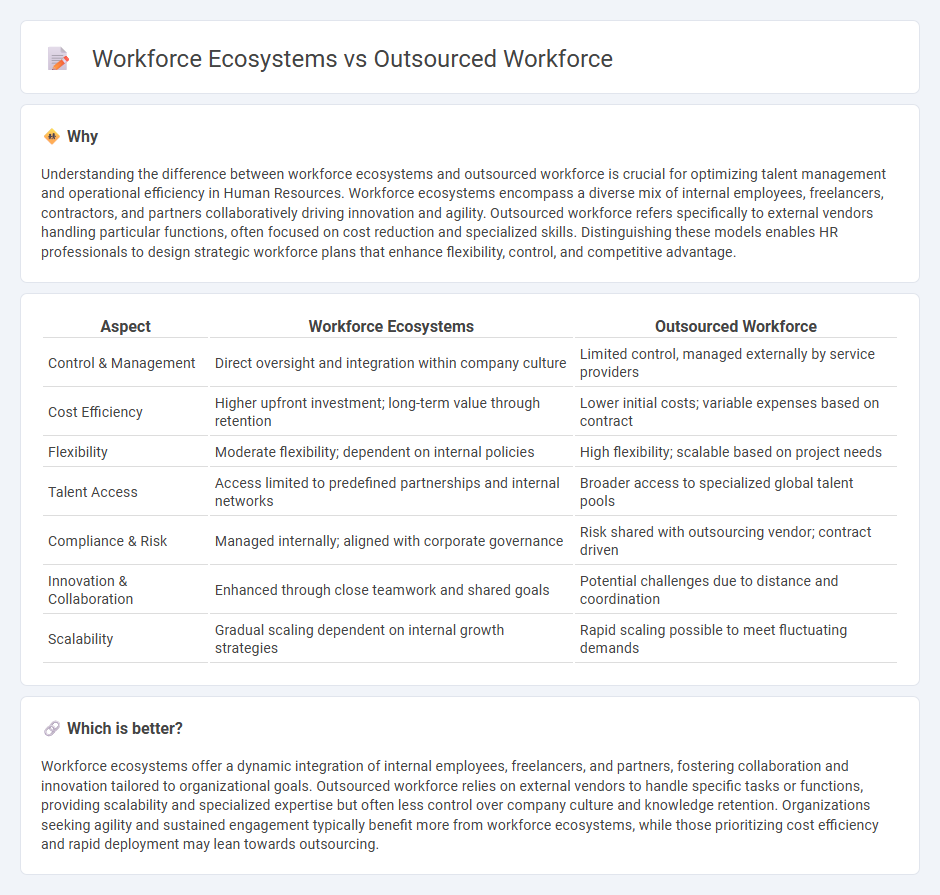
Workforce ecosystems integrate internal staff, contractors, and partners into a cohesive talent network, enhancing agility and innovation through strategic collaboration. Outsourced workforce models delegate specific business functions to external providers, offering cost efficiency and access to specialized expertise without expanding in-house resources. Explore how optimizing your workforce ecosystem versus outsourcing can drive competitive advantage and operational excellence.
Why it is important
Understanding the difference between workforce ecosystems and outsourced workforce is crucial for optimizing talent management and operational efficiency in Human Resources. Workforce ecosystems encompass a diverse mix of internal employees, freelancers, contractors, and partners collaboratively driving innovation and agility. Outsourced workforce refers specifically to external vendors handling particular functions, often focused on cost reduction and specialized skills. Distinguishing these models enables HR professionals to design strategic workforce plans that enhance flexibility, control, and competitive advantage.
Comparison Table
| Aspect | Workforce Ecosystems | Outsourced Workforce |
|---|---|---|
| Control & Management | Direct oversight and integration within company culture | Limited control, managed externally by service providers |
| Cost Efficiency | Higher upfront investment; long-term value through retention | Lower initial costs; variable expenses based on contract |
| Flexibility | Moderate flexibility; dependent on internal policies | High flexibility; scalable based on project needs |
| Talent Access | Access limited to predefined partnerships and internal networks | Broader access to specialized global talent pools |
| Compliance & Risk | Managed internally; aligned with corporate governance | Risk shared with outsourcing vendor; contract driven |
| Innovation & Collaboration | Enhanced through close teamwork and shared goals | Potential challenges due to distance and coordination |
| Scalability | Gradual scaling dependent on internal growth strategies | Rapid scaling possible to meet fluctuating demands |
Which is better?
Workforce ecosystems offer a dynamic integration of internal employees, freelancers, and partners, fostering collaboration and innovation tailored to organizational goals. Outsourced workforce relies on external vendors to handle specific tasks or functions, providing scalability and specialized expertise but often less control over company culture and knowledge retention. Organizations seeking agility and sustained engagement typically benefit more from workforce ecosystems, while those prioritizing cost efficiency and rapid deployment may lean towards outsourcing.
Connection
Workforce ecosystems integrate internal employees, outsourced workforce, and technology to create flexible and scalable talent solutions, enhancing organizational agility. Outsourced workforce contributes specialized skills and cost efficiency within this ecosystem, enabling companies to address fluctuating demands and diverse business needs. This interconnected model supports innovation and competitive advantage by leveraging external expertise and internal collaboration.
Key Terms
Vendor Management
Vendor management in outsourced workforce models centers on controlling third-party suppliers and ensuring contractual compliance to maintain operational efficiency. Workforce ecosystems extend beyond traditional outsourcing by integrating diverse talent pools, partnerships, and technology platforms to foster agility and innovation. Explore how optimizing vendor management strategies can transform your workforce ecosystem for sustained competitive advantage.
Talent Agility
Outsourced workforce models often provide businesses with flexible talent acquisition by leveraging external vendors for specialized skills, enabling rapid scaling based on project demands. Workforce ecosystems expand beyond traditional outsourcing by integrating diverse talent sources--including freelancers, consultants, and partners--into a dynamic network that fosters continuous collaboration and innovation. Explore how embracing workforce ecosystems can significantly enhance talent agility and drive competitive advantage.
Collaboration Platforms
Outsourced workforce relies on external vendors to perform specific tasks, often resulting in limited integration and communication challenges. Workforce ecosystems leverage collaboration platforms to seamlessly connect internal teams, contractors, and partners, fostering real-time communication, knowledge sharing, and operational agility. Explore how collaboration platforms transform workforce ecosystems to drive efficiency and innovation.
Source and External Links
The Growing Importance of Outsourcing Labor in Addressing Workforce Challenges - This article discusses the role of outsourcing labor in managing workforce challenges, such as talent shortages and high turnover rates, by providing flexibility and efficiency.
The Keys to Managing and Retaining an Outsourced Workforce - This guide explores strategies for managing and retaining outsourced teams effectively, emphasizing clear expectations, communication, and retention efforts.
Outsourced Workforce Solutions - Adecco provides full-spectrum solutions for managing projects, offering expertise in finding the right talent and managing projects efficiently.
 dowidth.com
dowidth.com